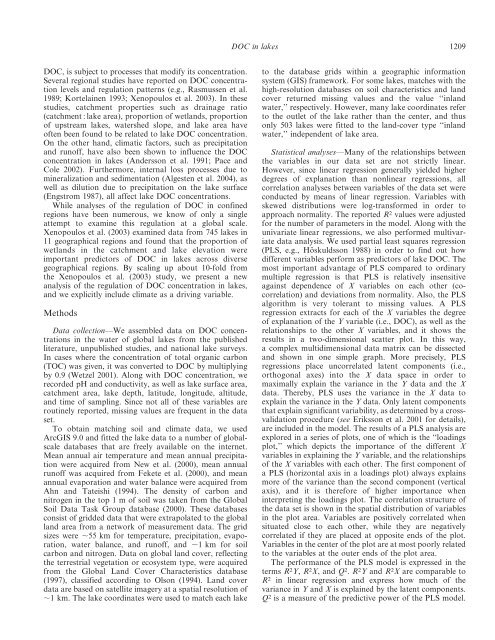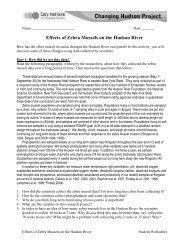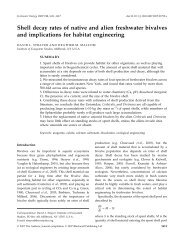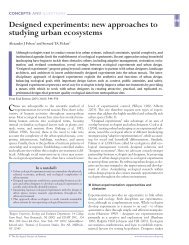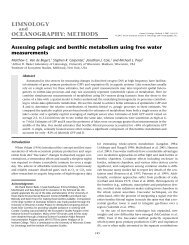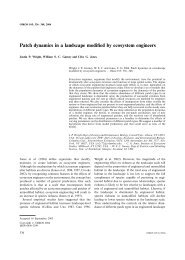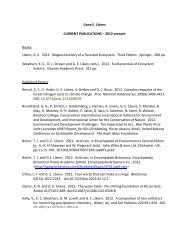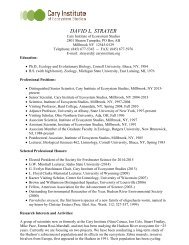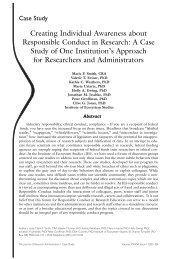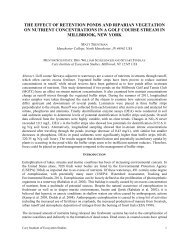Patterns and regulation of dissolved organic carbon
Patterns and regulation of dissolved organic carbon
Patterns and regulation of dissolved organic carbon
Create successful ePaper yourself
Turn your PDF publications into a flip-book with our unique Google optimized e-Paper software.
DOC in lakes 1209<br />
DOC, is subject to processes that modify its concentration.<br />
Several regional studies have reported on DOC concentration<br />
levels <strong>and</strong> <strong>regulation</strong> patterns (e.g., Rasmussen et al.<br />
1989; Kortelainen 1993; Xenopoulos et al. 2003). In these<br />
studies, catchment properties such as drainage ratio<br />
(catchment : lake area), proportion <strong>of</strong> wetl<strong>and</strong>s, proportion<br />
<strong>of</strong> upstream lakes, watershed slope, <strong>and</strong> lake area have<br />
<strong>of</strong>ten been found to be related to lake DOC concentration.<br />
On the other h<strong>and</strong>, climatic factors, such as precipitation<br />
<strong>and</strong> run<strong>of</strong>f, have also been shown to influence the DOC<br />
concentration in lakes (Andersson et al. 1991; Pace <strong>and</strong><br />
Cole 2002). Furthermore, internal loss processes due to<br />
mineralization <strong>and</strong> sedimentation (Algesten et al. 2004), as<br />
well as dilution due to precipitation on the lake surface<br />
(Engstrom 1987), all affect lake DOC concentrations.<br />
While analyses <strong>of</strong> the <strong>regulation</strong> <strong>of</strong> DOC in confined<br />
regions have been numerous, we know <strong>of</strong> only a single<br />
attempt to examine this <strong>regulation</strong> at a global scale.<br />
Xenopoulos et al. (2003) examined data from 745 lakes in<br />
11 geographical regions <strong>and</strong> found that the proportion <strong>of</strong><br />
wetl<strong>and</strong>s in the catchment <strong>and</strong> lake elevation were<br />
important predictors <strong>of</strong> DOC in lakes across diverse<br />
geographical regions. By scaling up about 10-fold from<br />
the Xenopoulos et al. (2003) study, we present a new<br />
analysis <strong>of</strong> the <strong>regulation</strong> <strong>of</strong> DOC concentration in lakes,<br />
<strong>and</strong> we explicitly include climate as a driving variable.<br />
Methods<br />
Data collection—We assembled data on DOC concentrations<br />
in the water <strong>of</strong> global lakes from the published<br />
literature, unpublished studies, <strong>and</strong> national lake surveys.<br />
In cases where the concentration <strong>of</strong> total <strong>organic</strong> <strong>carbon</strong><br />
(TOC) was given, it was converted to DOC by multiplying<br />
by 0.9 (Wetzel 2001). Along with DOC concentration, we<br />
recorded pH <strong>and</strong> conductivity, as well as lake surface area,<br />
catchment area, lake depth, latitude, longitude, altitude,<br />
<strong>and</strong> time <strong>of</strong> sampling. Since not all <strong>of</strong> these variables are<br />
routinely reported, missing values are frequent in the data<br />
set.<br />
To obtain matching soil <strong>and</strong> climate data, we used<br />
ArcGIS 9.0 <strong>and</strong> fitted the lake data to a number <strong>of</strong> globalscale<br />
databases that are freely available on the internet.<br />
Mean annual air temperature <strong>and</strong> mean annual precipitation<br />
were acquired from New et al. (2000), mean annual<br />
run<strong>of</strong>f was acquired from Fekete et al. (2000), <strong>and</strong> mean<br />
annual evaporation <strong>and</strong> water balance were acquired from<br />
Ahn <strong>and</strong> Tateishi (1994). The density <strong>of</strong> <strong>carbon</strong> <strong>and</strong><br />
nitrogen in the top 1 m <strong>of</strong> soil was taken from the Global<br />
Soil Data Task Group database (2000). These databases<br />
consist <strong>of</strong> gridded data that were extrapolated to the global<br />
l<strong>and</strong> area from a network <strong>of</strong> measurement data. The grid<br />
sizes were ,55 km for temperature, precipitation, evaporation,<br />
water balance, <strong>and</strong> run<strong>of</strong>f, <strong>and</strong> ,1 km for soil<br />
<strong>carbon</strong> <strong>and</strong> nitrogen. Data on global l<strong>and</strong> cover, reflecting<br />
the terrestrial vegetation or ecosystem type, were acquired<br />
from the Global L<strong>and</strong> Cover Characteristics database<br />
(1997), classified according to Olson (1994). L<strong>and</strong> cover<br />
data are based on satellite imagery at a spatial resolution <strong>of</strong><br />
,1 km. The lake coordinates were used to match each lake<br />
to the database grids within a geographic information<br />
system (GIS) framework. For some lakes, matches with the<br />
high-resolution databases on soil characteristics <strong>and</strong> l<strong>and</strong><br />
cover returned missing values <strong>and</strong> the value ‘‘inl<strong>and</strong><br />
water,’’ respectively. However, many lake coordinates refer<br />
to the outlet <strong>of</strong> the lake rather than the center, <strong>and</strong> thus<br />
only 503 lakes were fitted to the l<strong>and</strong>-cover type ‘‘inl<strong>and</strong><br />
water,’’ independent <strong>of</strong> lake area.<br />
Statistical analyses—Many <strong>of</strong> the relationships between<br />
the variables in our data set are not strictly linear.<br />
However, since linear regression generally yielded higher<br />
degrees <strong>of</strong> explanation than nonlinear regressions, all<br />
correlation analyses between variables <strong>of</strong> the data set were<br />
conducted by means <strong>of</strong> linear regression. Variables with<br />
skewed distributions were log-transformed in order to<br />
approach normality. The reported R 2 values were adjusted<br />
for the number <strong>of</strong> parameters in the model. Along with the<br />
univariate linear regressions, we also performed multivariate<br />
data analysis. We used partial least squares regression<br />
(PLS, e.g., Höskuldsson 1988) in order to find out how<br />
different variables perform as predictors <strong>of</strong> lake DOC. The<br />
most important advantage <strong>of</strong> PLS compared to ordinary<br />
multiple regression is that PLS is relatively insensitive<br />
against dependence <strong>of</strong> X variables on each other (cocorrelation)<br />
<strong>and</strong> deviations from normality. Also, the PLS<br />
algorithm is very tolerant to missing values. A PLS<br />
regression extracts for each <strong>of</strong> the X variables the degree<br />
<strong>of</strong> explanation <strong>of</strong> the Y variable (i.e., DOC), as well as the<br />
relationships to the other X variables, <strong>and</strong> it shows the<br />
results in a two-dimensional scatter plot. In this way,<br />
a complex multidimensional data matrix can be dissected<br />
<strong>and</strong> shown in one simple graph. More precisely, PLS<br />
regressions place uncorrelated latent components (i.e.,<br />
orthogonal axes) into the X data space in order to<br />
maximally explain the variance in the Y data <strong>and</strong> the X<br />
data. Thereby, PLS uses the variance in the X data to<br />
explain the variance in the Y data. Only latent components<br />
that explain significant variability, as determined by a crossvalidation<br />
procedure (see Eriksson et al. 2001 for details),<br />
are included in the model. The results <strong>of</strong> a PLS analysis are<br />
explored in a series <strong>of</strong> plots, one <strong>of</strong> which is the ‘‘loadings<br />
plot,’’ which depicts the importance <strong>of</strong> the different X<br />
variables in explaining the Y variable, <strong>and</strong> the relationships<br />
<strong>of</strong> the X variables with each other. The first component <strong>of</strong><br />
a PLS (horizontal axis in a loadings plot) always explains<br />
more <strong>of</strong> the variance than the second component (vertical<br />
axis), <strong>and</strong> it is therefore <strong>of</strong> higher importance when<br />
interpreting the loadings plot. The correlation structure <strong>of</strong><br />
the data set is shown in the spatial distribution <strong>of</strong> variables<br />
in the plot area. Variables are positively correlated when<br />
situated close to each other, while they are negatively<br />
correlated if they are placed at opposite ends <strong>of</strong> the plot.<br />
Variables in the center <strong>of</strong> the plot are at most poorly related<br />
to the variables at the outer ends <strong>of</strong> the plot area.<br />
The performance <strong>of</strong> the PLS model is expressed in the<br />
terms R 2 Y, R 2 X, <strong>and</strong> Q 2 . R 2 Y <strong>and</strong> R 2 X are comparable to<br />
R 2 in linear regression <strong>and</strong> express how much <strong>of</strong> the<br />
variance in Y <strong>and</strong> X is explained by the latent components.<br />
Q 2 is a measure <strong>of</strong> the predictive power <strong>of</strong> the PLS model.


